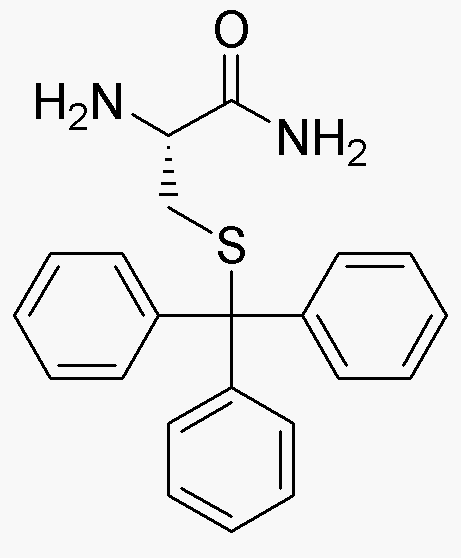S-Trityl-L-cysteine amide is widely utilized in research focused on:
- Drug Development: This compound serves as a valuable intermediate in synthesizing pharmaceuticals, particularly in the development of novel anti-cancer agents.
- Bioconjugation: It is used to attach biomolecules to surfaces or other molecules, enhancing the effectiveness of drug delivery systems in targeted therapies.
- Protein Engineering: Researchers employ it in modifying proteins to improve their stability and functionality, which is crucial in biotechnology applications.
- Antioxidant Research: The compound is studied for its potential antioxidant properties, contributing to the development of health supplements and functional foods.
- Analytical Chemistry: It is utilized as a standard in various analytical techniques, helping in the quantification and characterization of other compounds in complex mixtures.
General Information
Properties
Safety and Regulations
Applications
S-Trityl-L-cysteine amide is widely utilized in research focused on:
- Drug Development: This compound serves as a valuable intermediate in synthesizing pharmaceuticals, particularly in the development of novel anti-cancer agents.
- Bioconjugation: It is used to attach biomolecules to surfaces or other molecules, enhancing the effectiveness of drug delivery systems in targeted therapies.
- Protein Engineering: Researchers employ it in modifying proteins to improve their stability and functionality, which is crucial in biotechnology applications.
- Antioxidant Research: The compound is studied for its potential antioxidant properties, contributing to the development of health supplements and functional foods.
- Analytical Chemistry: It is utilized as a standard in various analytical techniques, helping in the quantification and characterization of other compounds in complex mixtures.
Documents
Safety Data Sheets (SDS)
The SDS provides comprehensive safety information on handling, storage, and disposal of the product.
Product Specification (PS)
The PS provides a comprehensive breakdown of the product’s properties, including chemical composition, physical state, purity, and storage requirements. It also details acceptable quality ranges and the product's intended applications.
Certificates of Analysis (COA)
Search for Certificates of Analysis (COA) by entering the products Lot Number. Lot and Batch Numbers can be found on a product’s label following the words ‘Lot’ or ‘Batch’.
*Catalog Number
*Lot Number
Certificates Of Origin (COO)
This COO confirms the country where the product was manufactured, and also details the materials and components used in it and whether it is derived from natural, synthetic, or other specific sources. This certificate may be required for customs, trade, and regulatory compliance.
*Catalog Number
*Lot Number
Safety Data Sheets (SDS)
The SDS provides comprehensive safety information on handling, storage, and disposal of the product.
DownloadProduct Specification (PS)
The PS provides a comprehensive breakdown of the product’s properties, including chemical composition, physical state, purity, and storage requirements. It also details acceptable quality ranges and the product's intended applications.
DownloadCertificates of Analysis (COA)
Search for Certificates of Analysis (COA) by entering the products Lot Number. Lot and Batch Numbers can be found on a product’s label following the words ‘Lot’ or ‘Batch’.
*Catalog Number
*Lot Number
Certificates Of Origin (COO)
This COO confirms the country where the product was manufactured, and also details the materials and components used in it and whether it is derived from natural, synthetic, or other specific sources. This certificate may be required for customs, trade, and regulatory compliance.


